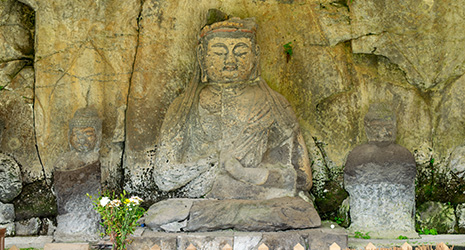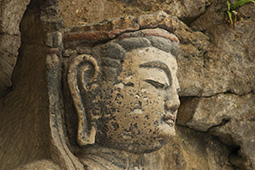INDEX
- English
- 日本語

A roughly 2.8-meter-high carving of the Dainichi Nyorai (National Treasure) in the Furuzono Cluster of Stone Buddhas, Usuki City, Oita Prefecture - English
- 日本語

The Hoki Cluster of carved Buddha images

Detail of the Dainichi Nyorai carving
October 2021
Stone Buddhas Reflecting the Passage of Time

Usuki City, Oita Prefecture is home to clusters of Buddha images carved into rock and known for their delicate and elegant forms. The expressive countenances of the “Usuki Stone Buddhas,” designated as a National Treasure, bring peace to the hearts of those who view them.

As a country blessed with abundant forest resources, Japan has an enduring culture of using wood as the main material for buildings, furniture, and tools, with Buddha statues too usually being made of wood. Buddha statues made of stone are more rare, but magaibutsu* like those found in India and China were made in some regions of Japan. One example is the “Usuki Stone Buddhas” designated as a National Treasure and Special Historic Site in Usuki City, Oita Prefecture, considered one of Japan’s most important collections of stone Buddha images due to their scale, the number of figures, and the high quality of their carving. Although collectively referred to as the “Usuki Stone Buddhas,” the magaibutsu are in fact found on different parts of the hillside in four clusters: the Hoki First Cluster, Hoki Second Cluster, Sannosan Cluster, and Furuzono Cluster. In total, 61 Buddha images are carved directly into the natural cliffs, ranging in height from around one meter to around 2.8 meters.
It is not actually clear when, by whom, or for what purpose these carved Buddha images were made.
“The prevailing theory is that they were commissioned by the Oga clan, which ruled the area from the end of the twelfth century. It’s thought that the Oga clan had the Buddha images carved into natural cliffs, from where they could not be moved, to ensure the lasting prosperity of the clan,” says Kanda Takashi, director of the Cultural Properties Research Office of the Usuki City Board of Education.
Kanda goes on to explain the characteristics of the carved Buddha images.
“The Usuki Stone Buddhas are regarded as precious due to their exquisite and elegant carving, which is rare among stone Buddhas. The location where the Usuki Stone Buddhas were carved consists of welded Aso tuff created by hardened pyroclastic flow that erupted from Mt. Aso in Kumamoto Prefecture, adjacent to Oita Prefecture. This material is easy to work with, having similar qualities to wood. Wood carving techniques for Buddhist statues had just become established during this period, which enabled craftsmen to apply the techniques to the creation of stone Buddha statues–circumstances that made these beautiful magaibutsu possible.”

When the Usuki Stone Buddhas were first carved, they were covered in a hut. They were not directly exposed to wind and rain but the hut eventually collapsed. They were then exposed to the weather for long years, and many of the Buddha carvings collapsed, losing heads and arms or other parts. However, in their dilapidated state they were noticed by a photographer. That was Domon Ken (1909–1990), a photographer who pursued realism. He photographed the Buddha carvings in their dilapidated state, later publishing them in a collection of his own works and bringing the Usuki Stone Buddhas to public attention. This led to the Usuki Stone Buddhas being appreciated for the aesthetic value of their naturally dilapidated state.
Nevertheless, large-scale restoration work on the Usuki Stone Buddhas was conducted between 1980 and 1993, and many parts of the carvings that had fallen off were returned to their original positions. Moreover, shelters were built to protect the magaibutsu from the wind, rain and falls in temperature.
Those parts of the magaibutsu which could not be returned to their original positions are being held in secure storage until a restoration method is established. However, completing the restoration will be no easy task.
“The Buddha carvings are not being restored simply by imagining the original positions of each displaced part,” says Kamatani Ryohei of the Usuki City Board of Education. “Rather, restoration work will only be worthwhile when we have established where the displaced parts were originally positioned and what form the carvings actually took at the time they were created.”
The Usuki Stone Buddhas reflect the passage of time from when the images were carved to the present. Although we still have no clear idea who created the Buddha images or why, their individual expressions communicate the thoughts and energy of those who lived some 900 years ago.
* Buddha figures carved directly into natural rock faces or cliffs

